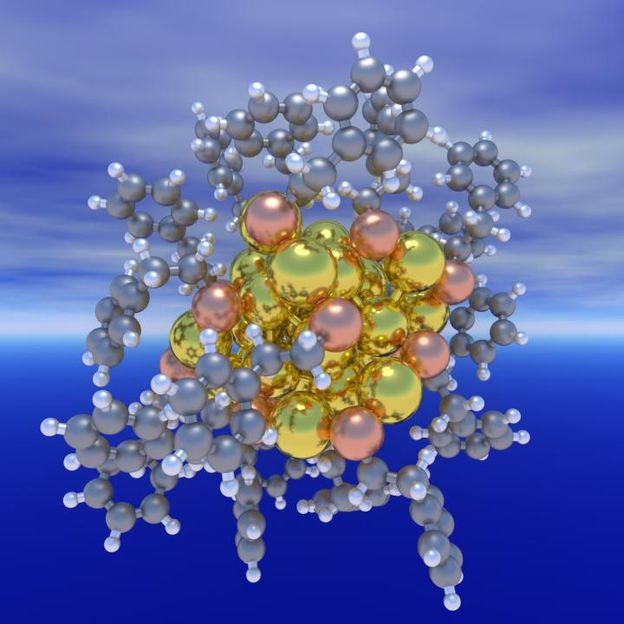How do you build a metal nanoparticle?
Although scientists have for decades been able to synthesize nanoparticles in the lab, the process is mostly trial and error, and how the formation actually takes place is obscure. However chemical engineers at the University of Pittsburgh's Swanson School of engineering explains how metal nanoparticles form.

This is a structure of a ligand-protected Au25 nanocluster.
Computer-Aided Nano and Energy Lab (C.A.N.E.LA.)
Giannis Mpourmpakis, assistant professor of chemical and petroleum engineering, and PhD candidate Michael G. Taylor conducted the reseach.
"Even though there is extensive research into metal nanoparticle synthesis, there really isn't a rational explanation why a nanoparticle is formed," Dr. Mpourmpakis said. "We wanted to investigate not just the catalytic applications of nanoparticles, but to make a step further and understand nanoparticle stability and formation. This new thermodynamic stability theory explains why ligand-protected metal nanoclusters are stabilized at specific sizes."
A ligand is a molecule that binds to metal atoms to form metal cores that are stabilized by a shell of ligands, and so understanding how they contribute to nanoparticle stabilization is essential to any process of nanoparticle application. Dr. Mpourmpakis explained that previous theories describing why nanoclusters stabilized at specific sizes were based on empirical electron counting rules - the number of electrons that form a closed shell electronic structure, but show limitations since there have been metal nanoclusters experimentally synthesized that do not necessarily follow these rules.
"The novelty of our contribution is that we revealed that for experimentally synthesizable nanoclusters there has to be a fine balance between the average bond strength of the nanocluster's metal core, and the binding strength of the ligands to the metal core," he said. "We could then relate this to the structural and compositional characteristic of the nanoclusters, like size, number of metal atoms, and number of ligands.
"Now that we have a more complete understanding of this stability, we can better tailor the nanoparticle morphologies and in turn properties, to applications from biolabeling of individual cells and targeted drug delivery to catalytic reactions, thereby creating more efficient and sustainable production processes."
Original publication
Other news from the department science
These products might interest you

NANOPHOX CS by Sympatec
Particle size analysis in the nano range: Analyzing high concentrations with ease
Reliable results without time-consuming sample preparation

Eclipse by Wyatt Technology
FFF-MALS system for separation and characterization of macromolecules and nanoparticles
The latest and most innovative FFF system designed for highest usability, robustness and data quality

DynaPro Plate Reader III by Wyatt Technology
Screening of biopharmaceuticals and proteins with high-throughput dynamic light scattering (DLS)
Efficiently characterize your sample quality and stability from lead discovery to quality control

Get the chemical industry in your inbox
By submitting this form you agree that LUMITOS AG will send you the newsletter(s) selected above by email. Your data will not be passed on to third parties. Your data will be stored and processed in accordance with our data protection regulations. LUMITOS may contact you by email for the purpose of advertising or market and opinion surveys. You can revoke your consent at any time without giving reasons to LUMITOS AG, Ernst-Augustin-Str. 2, 12489 Berlin, Germany or by e-mail at revoke@lumitos.com with effect for the future. In addition, each email contains a link to unsubscribe from the corresponding newsletter.

























































